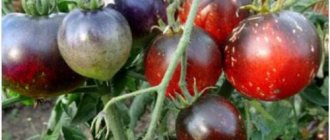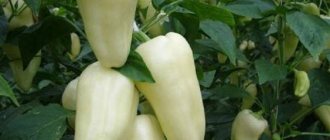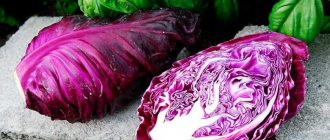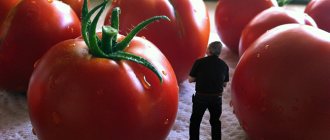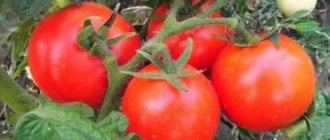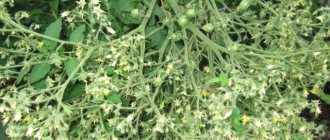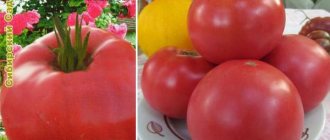Kumato tomatoes have one distinctive feature by which they cannot be confused with any other tomato variety - a black tint. The appearance of this color is due to the presence of certain substances in the composition that are responsible for cellular regeneration and activation of the rejuvenating function, for example, such substances include anthocyanin.
Interestingly, these black tomatoes of the Kumato variety contain an increased amount of vitamins. For example, the level of vitamin C in them exceeds the amount in yellow and red tomatoes by 2 - 3 times.
Kumato tomatoes: variety description
| Variety name | Kumato |
| general description | Mid-season indeterminate variety |
| Originator | Europe |
| Ripening period | 115-120 days |
| Form | Round or slightly oval, without pronounced ribs |
| Color | Dark |
| Average weight of tomatoes | 80 grams |
| Application | Universal |
| Productivity of the variety | 15 kg per sq.m |
| Features of cultivation | Standard agricultural technology |
| Disease resistance | Resistant to major diseases |
There is a lot of data on the breeders who received this variety, and they all differ.
It is only known that European scientists (most likely Belgian) developed the variety by crossing wild tomatoes from the Galapagos Islands with “domesticated” ones and adding a blackberry-based pigment. “Kumato” was not included in the State Register of the Russian Federation. Cultivation is available throughout the Russian Federation and other countries. The southern regions are the most favorable. The Kumato tomato variety is known to gardeners all over the world; it is especially loved to be grown in most European countries and Turkey. The plant is indeterminate, more than 2 m high , usually the top is pinched until it reaches 2 m, for favorable conditions for fruit development. The stem is persistent, bristly, liana-like, with medium foliage. Clusters with fruits on the plant - from 8 pieces.
The rhizome grows vigorously in all directions by more than 50 cm, without deepening. The leaves are small in size, dark green in color, “tomato” type, have a wrinkled surface without pubescence. The articulation is simple, intermediate - the first inflorescence is formed above the 9th leaf, the next ones come with an interval of 1 - 2 leaves. Pedicel with articulation.
In terms of ripening time, “Kumato” is mid-season, closer to late, the harvest can begin to be harvested 120 days after the seedlings emerge. Resistant to major tomato diseases . Cultivation is available in open ground and in greenhouses. In greenhouses, plants need to be pinched.
Late ripening
It is impossible to delay the sowing of seeds of such varieties; the ripening period is delayed up to 4 months (about 130 days). If you do not have time to harvest, frost will kill it. For this reason, it is better to use a greenhouse for growing. Late-ripening tomatoes are high-growing; the plant requires time to grow stems and leaves. Among the late species demanded by gardeners are:
- Vladimir F1
- Date fruit
- Titanium
- Bull's heart
Think in advance for what purpose you are growing fruits.
- Tomatoes of the correct shape, with firm skin and without a tendency to crack are suitable for canning. These are Sanka, Chocolate Bullet, Lapwing and others.
- Tomatoes with a small number of seeds, large sizes, and a sweet taste are suitable for harvesting raw and freezing. This is Bull's Heart, Giant, Cardinal, Mashenka.
- For food in the summer, choose Dessert, Pink Cherry, Danko, Infiniti F1, Cherry. These fruits are soft, juicy and sweet.
- Universal varieties can be preserved and enjoyed with pleasure during the period of full ripening. This is Shchelkovsky early tomato, Alaska, Cio-chio-san.
Characteristics
From 1 bush you can collect up to 8 kg of beautiful fruits that are almost identical in size . From 1 sq.m. On average, about 15 kg are collected.
Has a number of advantages:
- good harvest;
- high taste qualities;
- tolerate transportation well;
- are resistant to heat;
- resistant to most common diseases.
The only obvious drawback is the color - not everyone likes it. Minor isolated nuances were also noticed.
You can compare the yield of this variety with others in the table:
| Variety name | Productivity |
| Kumato | 15 kg per sq.m |
| Crimson Sunset | 14-18 kg per sq.m. |
| Inseparable hearts | 14-16 kg per square meter |
| Watermelon | 4.6-8 kg per sq.m |
| Giant Raspberry | 10 kg per bush |
| Black Heart of Brad | 5-20 kg per bush |
| Crimson Sunset | 14-18 kg per square meter |
| Cosmonaut Volkov | 15-18 kg per sq.m |
| Evpator | up to 40 kg per sq.m |
| Garlic | 7-8 kg per bush |
| Golden domes | 10-13 kg per sq.m |
Peculiarities:
- the main feature is the unusual color;
- the same regular round shape of the fruit is also not common;
- the seeds germinate fairly quickly, then growth slows down.
Shape - from round to oval, slightly ribbed. Dimensions - approximately 5-7 cm in diameter, weight - from 80 g. The fruits are the same in size. The color of unripe fruits is pale green without spots at the stalk, darkening begins over time, resulting in a chocolate (dark burgundy) color with thin stripes of green, sometimes without stripes.
The skin is dense, smooth, matte. The flesh is fleshy, ultra-dense, but tender. It has a dark red, sometimes greenish color. There are few seeds, distributed in regular proportions across 4 chambers. Dark fruits contain significantly more dry matter than ordinary red ones, more than 5%. The harvest is stored for a relatively long time, but it is better to use it immediately. It tolerates transportation over long distances well.
Black tomatoes "Kumato" have an excellent taste - sweet with fruit and berry notes, and the aroma is amazing. First of all, the Kumato tomato variety is intended for fresh consumption and is considered a dessert variety. Suitable for preparing salads, soups, and hot dishes. It tolerates canning well due to the high density of the fruit. Tomato paste and juice acquire an interesting unique taste. Taste and vitamins are not lost during heat treatment.
You can compare the weight of the fruits of this variety with others in the table below:
| Variety name | Fruit weight |
| Kumato | 80 grams |
| Gypsy | 100-180 grams |
| Japanese truffle | 100-200 grams |
| Nobleman | 300-400 grams |
| Cosmonaut Volkov | 550-800 grams |
| Chocolate | 200-400 grams |
| Spasskaya Tower | 200-500 grams |
| Newbie pink | 120-200 grams |
| Palenque | 110-135 grams |
| Pink icicle | 80-110 grams |
Harvesting and application
The harvest ripens in early or mid-July. It is better to pick ripe fruits from the bushes immediately, so they will be stored longer and will not lose their attractive appearance. And the plant will not waste its energy on ripened tomatoes, but will use it to ripen green fruits.
Unusual black tomatoes are good for health. This color is given to them by substances that are responsible for cell restoration and rejuvenation of the body. They also contain more vitamins and beneficial microelements than the fruits of traditional varieties. In particular, vitamin C and antioxidants.
Kumato tomatoes are perfectly stored and transported.
This variety is considered a dessert variety and is suitable for fresh consumption, in salads, and for making juices. During heat treatment, some of the beneficial properties are lost and the taste changes.
These tomatoes pair well with herbs, creamy, salty or blue cheese. Suitable as a snack with dry red wine.
Recommendations for cultivation
Growing dark-fruited varieties such as the Kumato tomato is no different from other tomato varieties. Seeds begin to be planted in early March, having previously been disinfected in a weak solution of potassium permanganate and washed with running water. Solution treatment is often used to stimulate seed growth.
The soil must be disinfected and steamed from microorganisms. Planting occurs to a depth of about 2 cm with a distance between seeds of 2 cm in fertile soil heated to 22 degrees in a wide container. Sprinkle the soil with seeds with warm, settled water and cover with plastic wrap or thin glass to create the required moisture. Humidity promotes good seed germination.
Read more about soil for seedlings and for adult plants in greenhouses. We will tell you about what types of soil for tomatoes exist, how to prepare the right soil yourself, and how to prepare the soil in the greenhouse for planting in the spring.
Place the container with future seedlings in a warm (about 25 degrees) well-lit place. After the majority of shoots have appeared (approximately on the 5th day), the coating is removed. When 2 well-developed leaves appear, the seedlings are planted in separate containers - they are planted. This contributes to better development of the root system and the plant in the future. The seedlings are fertilized with mineral fertilizers. Watering occurs as the soil dries, not frequently.
Plants are hardened off 2 weeks before planting. In mid-May, planting in a greenhouse is possible, in open ground - 2 weeks later, when the severe cold has passed. Plants are planted in holes at a distance of about 50 cm from each other; fertilizers with phosphorus should be placed in the holes . It is better to tie the plants directly to individual supports using synthetic materials. Watering, loosening and weeding - as necessary.
Mulching is encouraged. Feeding - according to schedule, with mullein and other mineral fertilizers (usually once every 10 days). The formation of a bush is not required; it grows in several stems; pinching of the lateral and lower shoots is necessary. In July you can harvest .
Read on our website: the most common diseases of tomatoes in greenhouses and ways to combat them. Which tomatoes are resistant to most diseases and immune to late blight? What methods of protection against late blight exist?
We collect seeds and prepare them for planting next year.
Tomatoes of the Kumato variety have not passed varietal tests in Russia, and therefore are not included in the registers of vegetable crops. The seeds of this vegetable variety are considered scarce.
To increase the yield of tasty and healthy vegetables, seed material is collected independently. To do this, during the process of harvesting vegetables, several fruits are left on the bushes. Overripe tomatoes are cut from the branches, and the seeds are selected, peeled from the pulp and dried at room temperature. The seeds are placed in a paper bag and stored in a dry place until the start of the next season.
Video
You can also watch the description of the Kumato tomato variety in the video:
| Mid-season | Mid-early | Late ripening |
| Anastasia | Budenovka | Premier |
| Raspberry wine | Mystery of nature | Grapefruit |
| Royal gift | Pink King | De Barao the Giant |
| Malachite Box | Cardinal | De Barao |
| Pink heart | Babushkino | Yusupovsky |
| Cypress | Lev Tolstoy | Altaic |
| Giant raspberry | Danko | Rocket |
If you find an error, please select a piece of text and press Ctrl+Enter.
